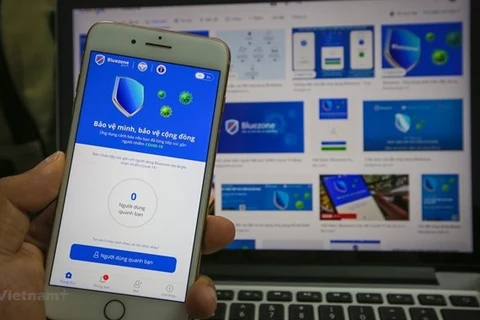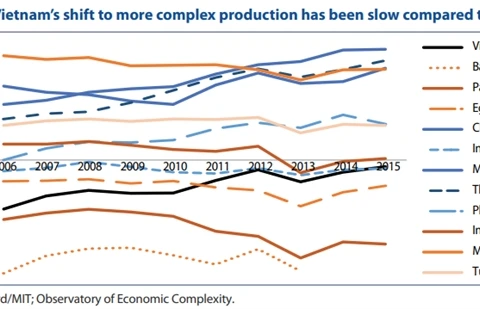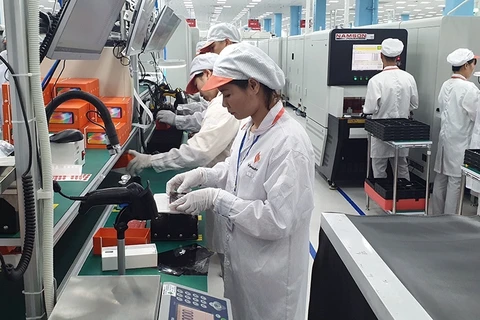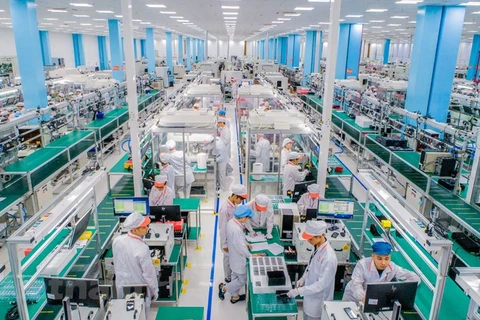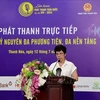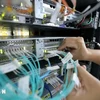 Technology research and application to serve natural disaster prevention and response to climate change. (Source: VNA)
Technology research and application to serve natural disaster prevention and response to climate change. (Source: VNA) Hanoi (VNA) - Deputy Prime Minister Vu Duc Dam has signed Decision No. 569/QĐ-TTg dated May 11 issuing a strategy for scientific-technological development and Innovation until 2030.
5. Developing science, technology and innovation human resources with high qualifications and creative capacity
a) Preparing science, technology and innovation human resources in the future. Stepping up training in science and technology and improving computer and foreign language skills, and creative design capacity associated with practical projects at high schools, especially through STEM (science, technology, engineering and mathematics) and STEAM (science, technology, engineering, arts and mathematics). Providing more career orientations and consultations on science, engineering and technical disciplines in high schools and universities.
b) Building highly qualified scientific and technological human resources; promptly building a contingent of leading scientists, step by step raising standards of leading scientists approaching those in developed countries. Continuing to implement the programme on selection and sending of trainees to training courses for highly-qualified scientific and technological human resources in priority and key fields in countries with advanced science and technology. Designing mechanisms to encourage and support domestic universities to collaborate with foreign universities in training scientific and technological human resources in Vietnam; and policies on personal income tax incentives for scientific and technological personnel engaged in performing national scientific and technological tasks.
c) Applying solutions to increase the quantity and quality of science, technology and innovation human resources to meet the needs of enterprises. Renovating training programmes for scientific and technological human resources in colleges and universities to meet requirements of the labour market. Creating channels for connection between training institutions and businesses to grasp enterprises’ demands for scientific research, technological development and innovation human resources. Setting up a mechanism for encouraging engineering and technology enterprises to receive university students as interns. Diversifying forms and materials of personnel training for enterprises through digital technology, social media and communication channels. Issuing handbooks on technology management and organising training programmes for enterprises.
d) Encouraging and supporting enterprises to develop human resources for technology management and corporate governance. Intensifying the mobilisation of social resources and diversifying training programmes for technology management and corporate governance personnel of enterprises at different levels. Including knowledge on management and economics, innovation, startup activities, intellectual property, standards, measurement and quality, and productivity in curricula of colleges, vocational schools and universities. Increasing spending on human resources development from science and technology funds of enterprises and providing credit incentives for human resources training.
dd) Promoting the attraction and shift of science, technology and innovation personnel on the basis of reviewing and revising relevant regulations so as to encourage two-way personnel shifts between the public and private sectors; adopting mechanisms and policies on funding and facilitating entry/exit, visa, work permit procedures to attract highly-qualified human resources from abroad and overseas Vietnamese to participate in science, technology and innovation activities in the country; developing networks connecting Vietnamese talents and attracting the participation and contribution of overseas Vietnamese scientists; designing policies to introduce Vietnamese people to work at multinational groups and startups abroad and then return to the country to work; smoothing policies to enable lecturers and researchers to regularly engage in science, technology and innovation activities at enterprises.
6. Developing and efficiently using science, technology and innovation infrastructure
a) Vigorously developing hi-tech parks, hi-tech agricultural zones and concentrated information technology areas. Reviewing and evaluating for improving relevant regulations toward consistency between the Law on High Technology and specialised laws with provisions related to specific mechanisms in infrastructure investment and human resources development in hi-tech parks, hi-tech agricultural zones and concentrated information technology areas. Fostering linkages and coordination between hi-tech parks and hi-tech agricultural zones with concentrated information technology areas and incubators, co-working spaces, business promotion organizations, key and specialized laboratories as well as with infrastructure development and living ecosystems.
b) Developing a system of key laboratories; evaluating and accrediting laboratories of institutes, universities, schools and enterprises as a basis for prioritising the allocation of resources to major research groups and talented scientists and technologists. Increasing state budget funds for the maintenance and warranty of equipment and machinery and for training technical staff to operate state-invested laboratories. Promulgating mechanisms and policies that enable state-invested laboratories to provide services for offsetting costs and reinvesting in regular upgrading activities; permitting institutes, schools and enterprises to use, and pay for state-invested laboratories.
c) Developing a system of international-level domestic science and technology journals. Making adequate investment in the system of domestic journals on the basis of ensuring a balance between different fields of science and technology and types of readers, and encouraging the application of digital technology and association with reputable publishing houses and magazines around the world. Improving qualifications of editors and increase the international diversity of editorial boards; attracting and encouraging scientists at home and abroad to publish high-quality articles on domestic journals. Issuing regulations compelling state budget-funded theses to be published on domestic journals.
d) Deploying the national quality infrastructure (NQI) uniformly from the central to local level, which are synchronous, modern and linked with the Fourth Industrial Revolution, meet requirements of the international integration process and help improve productivity based on science, technology and innovation. Developing the NQI index in the system of statistical indicators of the science and technology sector.
dd) Continuing to improve the capacity of the national information system on science, technology and innovation. Perfecting the national database on science, technology and innovation on the basis of developing and operating interconnected digital platforms, strengthening effective connectivity between scientific and technological information centres of ministries, sectors, localities, universities and research institutes; continuing to purchase a number of valuable core science and technology databases in the world that are of practical significance to domestic research activities. Promoting investment in and development of big data centres on science, technology and innovation and shared scientific data warehouses; connecting open science communities in Vietnam so as to share, criticize and build open data groups and open applications of Vietnam. Completing and enhancing the statistical management of science and technology.
7. Promoting science, technology and innovation activities in enterprises
a) The State shall assist enterprises in improving their access to domestic and international technology information. Developing and providing tools and services for analysing patent information and forecasting technology development trends with a view to setting orientations for science, technology and innovation activities. Building state-invested centres offering science, technology and innovation services as well as consultancy and brokerage services on technology or through providing assistance, strengthening the linkage between private counseling centres and enterprises.
b) Reviewing and amending regulations on tax, finance and credit to make them consistent with those on science and technology so as to effectively implement incentive mechanisms for enterprises which invest in scientific research and technological innovation. Shortening the period of depreciation of machinery and equipment for scientific research and technological development activities. Formulating and implementing an annual tax incentive mechanism for enterprises based on their actual turnover from activities on the list of science, technology and innovation activities. Designing a mechanism for crediting income tax for individuals and enterprises that make donations for science, technology and innovation activities of research institutes and universities.
c) Speeding up the formation and development of scientific research and technological development divisions in enterprises. Facilitating the development of a number of domestic enterprises reaching the region’s leading technological level. Reviewing, adjusting and perfecting the legal corridor that allows the use of scientific and technological outcomes/intellectual assets as capital contribution to establish enterprises.
d) Promoting the transfer of knowledge and training of science, technology and innovation personnel through foreign direct investment (FDI) enterprises. Reviewing and improving incentive policies for FDI enterprises employing highly qualified Vietnamese employees and carrying out scientific research and technological development activities in Vietnam in order to achieve the goal of pervasive technology application. Adopting policies to encourage domestic enterprises to enter into joint ventures with FDI enterprises. Establishing research institutes next to FDI enterprises to learn experience from the latter.
dd) Concentrating on implementing solutions to develop the science and technology market and solutions to increase outlets for products of enterprises. Continuing to improve the competitive environment in trade, raising standards for goods sold and services provided in the country, supporting the wide implementation of intellectual asset management tools and methods, promptly issuing new standards for new technologies and reforming technical barrier to trade (TBT) support activities so as to promote science, technology and innovation in production and business activities. Considering and proposing amendments to policies on public procurement to promote the use of products and services which are outcomes of scientific research and technological development activities in the country. Continuing to support, develop and promote digital transformation in the system of intermediary organisations providing search, evaluation, valuation, brokerage, testing and technology transfer services. Connecting technology exchanges with centres for application and transfer of scientific and technological advances in localities in order to form a unified and comprehensive network to provide the best support for technology innovation activities of enterprises. Reviewing, evaluating and perfecting policies on technology import (tax incentives, credit, support, etc.) to intensify the transfer of advanced technologies from abroad.
e) Continuing to review, adjust and implement mechanisms and policies to strongly develop science and technology enterprises, hi-tech enterprises and innovative startups. Encouraging businesses to invest in research and application of hi-tech, new-technology and digital transformation solutions developed by domestic enterprises instead of imported ones.
g) Increasing assistance for the operation of business associations in order to promote linkage of science, technology and innovation activities among enterprises. Building a network of consultants directly providing enterprises with consultancy on technology management and corporate governance through associations.
8. Proactively promoting international cooperation and integration on science, technology and innovation
a) Strengthening international cooperation in scientific research, technological development and application, trading in and transfer of scientific and technological products, implementation of innovative models and solutions, protection and development of intellectual assets, and assurance of goods standards and quality. Promoting inclusion of contents on capacity building and technology transfer in international agreements and treaties to which Vietnam is a party.
 Promoting cooperation between the Vietnamese and US parliaments in science and technology (Photo: VNA)
Promoting cooperation between the Vietnamese and US parliaments in science and technology (Photo: VNA) b) Actively expanding international cooperation toward supporting a number of science and technology fields in order to bring them to international level. Fostering international cooperation for learning and transferring advanced management models on science, technology and innovation so as to improve the capacity of management apparatuses at all levels.
c) Proactively making effective contributions to the formulation of international frameworks and laws on science, technology and innovation. Actively joining in international research alliances on emerging issues such as COVID-19 vaccines, climate change, etc. The State shall facilitate the participation of enterprises in international research alliances (introducing and providing guarantee for Vietnamese enterprises to engage in research and acquire transferred technologies, etc.).
9. Increasing honouring and communication activities to raise awareness of science, technology and innovation
a) Continuing to maintain and develop national research awards for researchers with outstanding achievements. Designing more awards for innovation activities and enterprises with innovation activities.
b) Encouraging and supporting the youth to improve their science and technology knowledge and provide them with career orientations in the field of science and technology. Investing in establishing a number of television channels, publications and social media channels on science, technology and innovation, particularly those for children and teenagers. Expanding, improving quality of, intensifying communications, and promoting social investment in science, technology and innovation contests and playgrounds for children and teenagers.
c) Continuing to step up communication campaigns about science, technology and innovation. Diversifying types of communication on digital platforms and social media; requiring outcomes of scientific and technological tasks funded by the state budget to be widely disseminated in the mass media. Promoting communications about enterprises with production and business turnover generated from outcomes of scientific and technological activities in order to increase their brand value, win trust of consumers and improve competitiveness of science and technology enterprises and hi-tech enterprises. Strengthening communications about and increasing the State’s support for initiatives on technical improvements by the people. Developing forms of science, technology and innovation displays and museums that can serve a wide range of visitors across the country.
(to be continued)
Part 1: Strategy for Science, Technology and Innovation Development until 2030 approved
Part 2: Strategy for Science, Technology and Innovation Development until 2030 approved
Part 3: Strategy for Science, Technology and Innovation Development until 2030 approved
